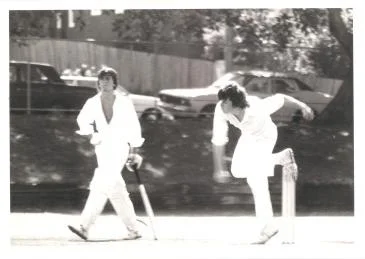On Remembrance Day, James Rodgers continues the series in which he commemorates the Sydney University cricketers who died serving in the First World War, a century ago. Today: Roger Forrest Hughes.
Captain Roger Forrest Hughes was born in Sydney 6 May 1890 and died of wounds near Flers, France on 11 December 1916.
Roger Forrest Hughes was one of the best and brightest of his generation produced by the University of Sydney. He entered the University in 1908, studying Classics for which he continued to earn distinctions until graduating with a Bachelor of Arts. He immersed himself in undergraduate life in the Debating Society, the Dramatic Society and as Secretary of the University Union. He played Hockey for the University (winning his Blue in 1912) and played every season for the Cricket Club as a batsman from 1908 until 1913 – without great achievements, although he turned out faithfully in the Thirds, for which team he was a selector. In games for which records were kept, he batted 29 times in Thirds for 485 runs and once in Seconds in 1910-11 without scoring. The 1912-13 SUCC Annual Report, however, gives some indication of the continued frustration caused by haphazard organisation of the Club’s lower grades. When Third Grade’s scoring book was again lost, the Club’s secretary, Claude Tozer, allowed himself a restrained but pointed: ‘It is a matter of concern that the executive part of the team’s work is not looked after as it should be…’
Roger Hughes progressed to study Medicine after graduating in Arts and he thrived, graduating MB ChM in 1915.
He was the second son of Sir Thomas Hughes, 1863-1930 (the first Lord Mayor of Sydney by that title, in 1902, 1903, 1907 and 1908) and Lady Louisa (nee Gilhooley). His uncle was John Francis Hughes (1857-1912), a minister in the NSW Governments of the 1890s and 1900s. His parents sent Roger to St Ignatius’ College Riverview in 1901 and accolades for academic excellence followed him every year until he was Dux of the College in 1907. He won the Gold Medal for Senior Debate, the trophy for Oratory, and sports prizes for athletics as a sprinter, for Rugby as a five eighth in the 1st XV and as a middle order batsman in the 1st XI. His obituarist, writing in the College Magazine for 1916, strikes a poignant note when one realises that this has been a life of great promise cut short: ‘Roger’s career at Riverview, and at the University, was a brilliant one. It would have been hard to find a brighter or more willing personality. To his old College, he was loyal to the heart’s core.’
In 1915, he served as RMO at St Vincent’s Hospital where he was much admired, before enlisting in December 1915 and being appointed RMO at No 4 Australian General Hospital, Randwick. He sailed from Sydney on 8 August 1916 on the ‘Wiltshire’, arriving in England on 13 October.
The Hughes family gave so many to Australia’s cause in the Great War. Five of Roger Hughes’ cousins, all alumni of St Ignatius’ College, were killed. This established and prosperous Sydney family and the College saw it as a duty to encourage their sons to lives of service, even service for war.
Hughes was at the front for only five days. On 11 December 1916, while attending to a wounded soldier, he was hit by a shell that fractured both legs and that killed his patient. Hughes was taken to 36th Casualty Station where his younger brother, Captain Geoffrey Hughes, was, by chance, at his side in his final hours. He was laid to rest in a ceremony conducted by Father Prescott in Heilly Station Cemetery, Mericourt-L’Abbe. Geoffrey Hughes and a brother in law, Captain Austin Curtin, said prayers at the graveside.
His loss was felt keenly in Australia. A solemn requiem Mass was celebrated at St Mary’s Cathedral in Sydney by Archbishop Michael Kelly with two of his cousins, John and James Hughes, serving the Mass. James Hughes had played for 1st Grade for SUCC from 1904 until 1909, and three of the brothers (Bryan was later killed in France in August 1918) were representative Rugby players, James and Bryan playing for Australia.
Roger had married Eileen Maher on 2 March 1916 at St Canice’s Church in Sydney. The land had been a gift of the Hughes family to the Catholic Church and there is now a stained glass window in memory of Captain Roger Hughes in the church. Eight weeks after his father’s death, his son, Peter Roger Forrest Hughes, was born on 4 February 1917. The family was to be visited by extraordinary tragedy during World War II. In 1942, on an operational flight with the RAAF, Roger Hughes junior was killed over Darwin. Then, his mother was killed in a car accident in May 1946 on her way to visit her son’s grave.
Captain Geoffrey Hughes (1895-1951) was awarded the Military Cross in May 1918 and his line of the family continued the distinguished surname as they contributed significantly to Australian public life. His three sons were Thomas Hughes QC, (1923- ), eminent barrister and Federal Attorney General of Australia 1969-71, Geoffrey Hughes, a renowned lawyer, and Robert Studley Hughes (1938-2012), internationally famous art critic. One of Thomas Hughes’ daughters, Roger Forrest Hughes’ great niece, Lucy, followed her great grandfather as Lord Mayor of Sydney, 2003-04. She is married to the Prime Minister of Australia, Malcolm Bligh Turnbull.







